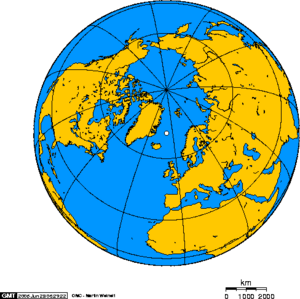Jan Mayen: Difference between revisions
Jump to navigation
Jump to search

George Swan (talk | contribs) (more details) |
Pat Palmer (talk | contribs) m (Text replacement - "World War 2" to "World War II") |
||
| (3 intermediate revisions by 2 users not shown) | |||
| Line 1: | Line 1: | ||
{{subpages}} | |||
[[File:Jan_Mayen_orthographic.png | thumb | 2002 EB5 entered the Earth's atmosphere near Iceland and Jan Mayen close to midnight on March 11, 2002.]] | [[File:Jan_Mayen_orthographic.png | thumb | 2002 EB5 entered the Earth's atmosphere near Iceland and Jan Mayen close to midnight on March 11, 2002.]] | ||
'''Jan Mayen''' is an uninhabited island, north of [[Iceland]]. Administratively it is part of [[Norway]]. | '''Jan Mayen''' is an uninhabited island, north of [[Iceland]] and south of [[Svalbard]]. Administratively it is part of [[Norway]]. | ||
In the 17th, 18th and 19th centuries whalers intermittently maintained whale processing facilities on the Island. | In the 17th, 18th and 19th centuries, whalers intermittently maintained whale processing facilities on the Island. | ||
During World War | During World War II the Allies maintained a small weather station for most of the war. Germany tried and failed to establish its own weather station there. | ||
In 2010 Norway declared the Island a Nature Reserve. | In 2010 Norway declared the Island a Nature Reserve. | ||
Latest revision as of 09:49, 23 February 2024
Jan Mayen is an uninhabited island, north of Iceland and south of Svalbard. Administratively it is part of Norway.
In the 17th, 18th and 19th centuries, whalers intermittently maintained whale processing facilities on the Island.
During World War II the Allies maintained a small weather station for most of the war. Germany tried and failed to establish its own weather station there.
In 2010 Norway declared the Island a Nature Reserve.
